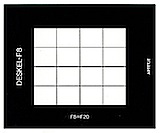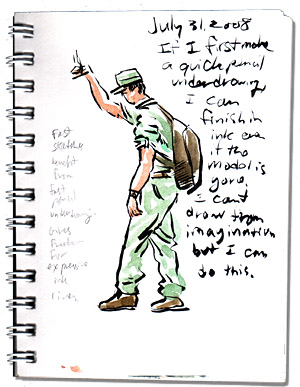 | ||
|
Page 11. How to Sketch Sketching and art in general is not like math where there is but one answer. There are no real rules in sketching (except maybe don't put the paint in your mouth because it can kill you).
Most books on how to sketch (including this one) can also be subtitled How the author sketches, and how you can sketch like him if you are so inclined. Anything I suggest may take you closer to your ideal sketching style, or it may take you farther from it! Here are some tips which you may find relevant. Feel free to embrace or reject what I say as it relates to your goals. Simple sketches: Just jump right in! When you find a subject and open your sketchbook, that blank page can put fear into your heart. It happens frequently even to sketchers who have been at it for years. How do you begin? Just jumping right in and checking your brain at the door is one good way if you can manage it. This works especially well for simple subjects. Your fingers can instinctively guide the pencil to the right place if your brain doesn't get in the way. I say pencil because this technique works best with the least intimidating tool, which is a pencil. You can jump in with a pen or brush but it takes more courage. But it does get easier after you have had a few positive experiences with it. If I'm sketching a person on the subway with a brush pen, I'll often just jump right in with ink, usually starting with the top of the head and working my way down. The nature of brush lines is spontaneous and lively, and there is a lot of freedom to deviate from the model when sketching strangers. Visualize the sketch on paper If you are sketching something big or complex, one way to begin is to stare at the subject and then quickly look at the paper, and then back at the subject, and then back at the paper, over and over until you can imagine it as a sketch on the paper, in the proper size. After a while you can actually see a faint image of the subject on the paper in your imagination. If you can imagine the subject as a sketch in your style, then the battle is already won. This is also a key to sketching mundane subjects. If you can see in your mind's eye a dull subject as it would appear already drawn in your style, then you can unlock the excitement and bring that vision to reality. This ability to see objects already sketched in your imagination will open up a world of possibilities, and you never have to go far to find a great sketch. Trace it in the air Also, with big, complex subjects such as a row of buildings, you will need to get a feel for the subject. One way is to take your pencil and trace the subject in the air between you and the subject to get a feel for the relationships and angles of the various parts. In addition, like many sketchers, I often hold my pencil out in front of me to determine the angle of lines caused by perspective. More often than not, though, I just raise the top or side edge of my sketchbook to see how it compares with the angles and perspective lines in the subject before me. The results usually surprise me.
Grids A lot of books on sketching by Japanese artists recommend little transparent plastic cards (about the size of a postcard) with grid lines printed on them as a way of understanding spatial relationships as well as discovering a pleasant composition of elements.
I bought one, but couldn't get accustomed to using it. I personally felt it took away my freedom to interpret scenes for myself, and the hand holding the grid kept moving, distorting reality. Still, you may find one beneficial. The one I had was called Deskel. I've also seen identical ones called Dessin Scale. They come in various proportions to match your particular sketchbook. They would be easy enough to make with clear plastic sheets and a pen or marker. You could even create a perfect grid on your computer and print it on a transparent sheet. Underdrawings: Capture and Render While jumping right in makes for a more lively sketch, underdrawings assure more accuracy. Both are good things. For any complex sketch, especially involving architecture I would use a light pencil underdrawing in addition to visualizing on paper and tracing the subject in the air as mentioned above. Don't spend too much time on an underdrawing, but just enough to understand the spatial relationships, and gain a sense of confidence. As soon as you feel you can tackle the subject, switch to ink (or heavier, more deliberate pencil lines).
I call it Capture and Render because the two are different stages of a sketch requiring different approaches (and different tools if you sketch in ink). First capture the subject quickly with a light pencil underdrawing, and then render it in ink. This gives you the freedom to concentrate on your sketch without panicking if the subject is no longer there. I must confess that I have a hard time drawing even simple subjects purely from imagination from scratch, and that includes people although I've been drawing people all my life. I need something to get me started, some sort of a spring board. If I have even the slightest pencil indication of a pose caught in a just a brief moment including the direction of wrinkles in the clothes, I can then complete it in ink partially from imagination, filling in details, and drawing on my memory of dozens of similar poses from the past. Quick trial sketches For complex subjects, even a pencil underdrawing may not be enough to understand the subject and get that sense of confidence. Sometimes you need to do a lot more scribbling and experimenting which would make for a messy final product. In such cases it's best to do the scribbling on a separate piece of paper.
You can make a fast small rambling exploratory sketch to discover all the obstacles as well as the spatial relationships between the elements and the tonal values (lights and darks). You might even want to add color to this quick sketch. Surprising elements and relationships will become apparent, and you will discover that you have not really seen your subject until you made this exploratory sketch. Then you can look at this quick sketch and ask yourself "Is this subject worth investing more time and energy in a more comprehensive sketch?"
If this small sketch tells you the subject is too complex or ambiguous or just not worth pursuing, you can abort before you have invested much time and energy, and look for something else to sketch. You still have that small sketch as an interesting record of your experience, so the time was not wasted.
If you discover the sketch is worth pursuing, then the subject will no longer be uncharted territory, and you even have the benefit of a rough map of light and shadow for when the sun has changed its position.
| ||||||||||||||||||
Next page >> |
 |
 The cards are fairly thick and stiff and you hold them between you and the subject and look through it as if it were a window, and draw with reference to the grid which is now superimposed on the subject. It's a classic method of drawing, and many artists in Japan swear by them. Some public schools even make them required equipment for art classes (my nephew had brought one home from school but had no idea what it was).
The cards are fairly thick and stiff and you hold them between you and the subject and look through it as if it were a window, and draw with reference to the grid which is now superimposed on the subject. It's a classic method of drawing, and many artists in Japan swear by them. Some public schools even make them required equipment for art classes (my nephew had brought one home from school but had no idea what it was).